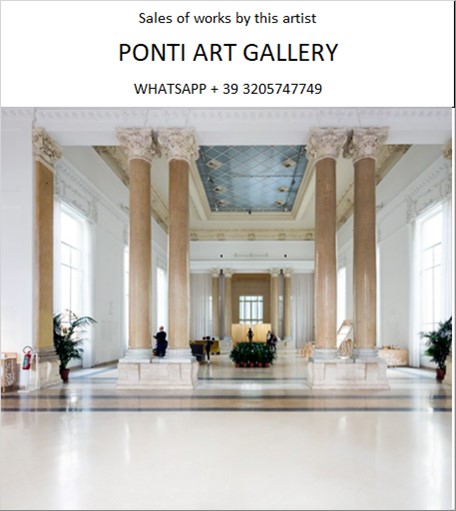Ponti Art Gallery is interested in buying and selling works
of art by this artist.

Mrinalini Mukherjee Biography
Mrinalini Mukherjee was an Indian sculptor whose innovative and distinctive style left an indelible mark on the world of contemporary art. Born on October 29, 1949, in Mumbai, India, she was the only child of prominent artists Benode Behari Mukherjee and Leela Mukherjee. Her father was a pioneering figure in modern Indian painting, and her mother was a skilled sculptor. Growing up in an artistic environment, Mukherjee was naturally inclined towards the arts from a young age.
Mukherjee's formal education in art began at the Maharaja Sayajirao University of Baroda, where she pursued a diploma in painting, graduating in 1970. She continued her studies at the same university, completing a postgraduate diploma in mural design in 1972 under the tutelage of K.G. Subramanyan. Subramanyan, a renowned artist and teacher, was instrumental in shaping Mukherjee's artistic vision. He encouraged his students to explore and integrate traditional Indian art and craft techniques into their work, a philosophy that deeply influenced Mukherjee's practice.
During her studies, Mukherjee discovered her affinity for natural fibers, particularly jute ropes, which she encountered at an annual fair in Baroda. This marked the beginning of her lifelong exploration of fiber as a medium for sculpture. Her early works were wall-based, but she soon transitioned to creating three-dimensional sculptures. Mukherjee's sculptures were characterized by their dense knotting and vibrant colors, often drawing inspiration from Hindu mythology and the natural world.
In 1978, Mukherjee's artistic journey took her to the United Kingdom, where she received a British Council Scholarship for Sculpture to study at the West Surrey College of Art and Design. This period of study abroad allowed her to further experiment with jute sculptures and refine her labor-intensive weaving techniques.
Upon her return to India, Mukherjee continued to develop her unique style, creating organic, sinuous shapes that referenced the human body and the lush flora of her homeland. Her sculptures from the 1980s and 1990s, such as "Van Raja" and "Sitting Deity," were increasingly mystical and totemic, commanding a powerful physical presence. Despite their anthropomorphic qualities, Mukherjee was careful to avoid direct references to specific gods or deities, preferring to create a personal and de-conventionalized mythology.
Mukherjee's choice of materials was unconventional for sculpture. She worked extensively with dyed and woven hemp fiber, a medium not traditionally associated with sculptural practices. Her innovative use of fiber challenged the boundaries between art and craft, and her sculptures often blurred the lines between figuration and abstraction. She never worked with a loom; instead, knotting became her primary technique, which lent her sculptures a three-dimensional volume and a sense of monumentality.
By the mid-1990s, Mukherjee began experimenting with ceramics, and in the early 2000s, she ventured into working with bronze. Her bronze sculptures, created using an improvised version of the lost-wax technique, were as fluid and dynamic as her fiber works. Mukherjee's sculptures in bronze, such as "Cluster" and "Palmscape," maintained a sense of pliability and organic movement, despite the solidity of the medium.
Throughout her career, Mukherjee's work was exhibited widely, both in India and internationally. Her sculptures are part of public collections at prestigious institutions such as the Museum of Modern Art in Oxford, the National Gallery of Modern Art in New Delhi, Tate Modern in London, The Metropolitan Museum of Art in New York, and the Stedelijk Museum in Amsterdam.
Mukherjee's work received significant recognition posthumously with the exhibition "Phenomenal Nature: Mrinalini Mukherjee" at The Met Breuer in New York in 2019. This retrospective marked the first comprehensive display of her work in the United States and brought together 57 pieces that showcased her engagement with fiber and her forays into ceramic and bronze.
Mrinalini Mukherjee passed away on February 15, 2015, leaving behind a legacy of innovation and a body of work that continues to inspire and awe. Her sculptures, characterized by their sensual and organic forms, stand as a testament to her mastery of materials and her unique vision that transcended cultural and generational boundaries. Mukherjee's work remains a significant contribution to the field of modern and contemporary sculpture, celebrated for its radical intervention and the seamless integration of traditional craft with modernist formalism.
Mrinalini Mukherjee Quotes and
Sales of Works
Ponti Art Gallery selects and deals with paintings by the
artist. Upon request, we provide free estimates and
evaluations, communicate prices, quotations, and current
market values.
If you are interested in BUYING or SELLING works by the
artist, contact us immediately.
If you wish to sell or receive an evaluation of the
works:
Send us a frontal photo of the painting, one of the back,
and one of the signature. Also, indicate the dimensions of
the work. Inform us about the purchase origin of the work
and any kind of available documentation (purchase
receipts, certificates of authenticity, publications). One
of our operators will respond to you on the same day. We
guarantee maximum confidentiality and extreme
professionalism.
If you wish to purchase works by the painter: Contact us
and let us know your request. We will inform you about the
available works. We also offer the possibility to
subscribe to our NEWSLETTER, through which you will be
informed at the beginning of each month about the latest
acquisitions of the art gallery.
You can send us pictures of the work:
